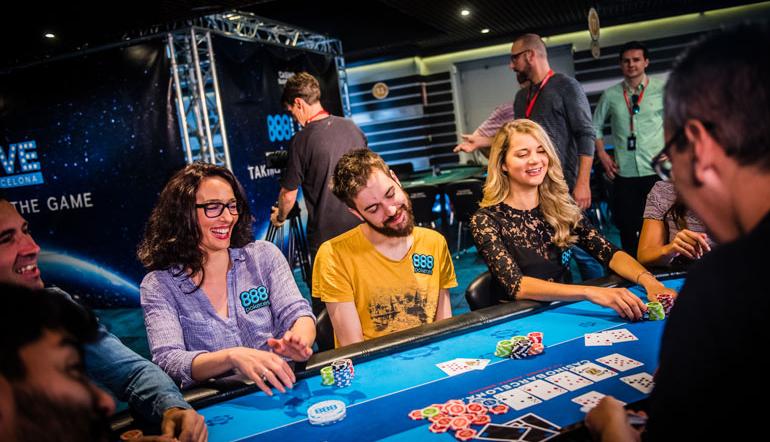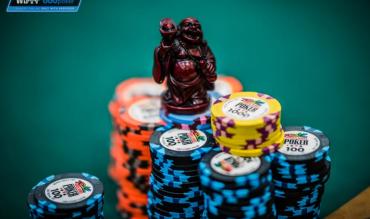Barrelling (verb): Betting either the flop and turn (a double barrel) or all three streets (a triple barrel) as a bluff.
The few seconds after a successful triple barrel bluff is about the closest poker players get to a legitimate mic drop moment. Not only have you just scooped a pot with (what you assumed to be the worst hand), the dead money from the flop and turn means that you probably needed two hands and a shovel to do so.
Winning tournaments is fun and all, but there’s just something so satisfyingly thrilling about bluffing. Like dragon-slaying or drinking coke after a tube of Mentos, it's is all about bravery.
You show everyone what you're capable of achieving. Opponents quake, and you salivate as their knees tremble. Weaker players begin to fear you, smart players find easier targets, and you start to face far less resistance as a consequence. Poker becomes easier.
Table of Contents
Barrelling Takes More than Skill
There’s no doubt about it, barrelling is risky - like tightrope walking over a canyon – one wrong move, and you're toast. Barrelling takes sizable cajones, but, before any guys reading start sticking their hands down their pants and sizing up their giggle-berries, remember, there's a fine line between a well-considered barrel and total financial spew.
With this in mind, let's break down some key things to consider when deciding whether or not to pull the trigger.
Know Your Opponents
Barrelling is a high-risk play so, it's essential to consider what you know about your opponent before you start throwing bets around wildly –
- Who are they?
- What position are they in at the table?
- Are they stubborn, annoyed or egotistical?
- Are they lose passive, drunk or barking like a dog and writing their names in poop on the wall during a break (don't bluff this guy!)?
Pretty much anything you can muster up about both their personalities and ranges should be useful. Nobody ever pulled up a seat and said, “You know what guys, I really can't wait to start folding!” It just doesn't happen!
Calling is just way more fun, so it's probably a good idea to know that they're capable of finding the fold button before you start throwing huge bets in their direction.
Knowing your opponents well can save you a fortune.
Consider the following two guys - you'll see them a lot at the tables.
1: Calling Stations
Calling Stations like folding about as much as a teenager on laundry day. And, since they're always looking for a reason call, the chances are that if they see you bluff-barrelling once, they're going to use it to justify the abolition of their 'fold' button for the next six months.
Against this player, you probably shouldn't barrel very often (if ever). They call too much, so stick to value-betting and size your bets up as a default – It's the most effortless adjustment.
If for some reason you do decide to start firing though, make sure you have a solid rationale (and some kind of high equity draw or read) and do so infrequently.
Since you're not going to be bluffing a lot, when you do pull the trigger, make sure they know about it afterwards. They'll never forget it, and you can revert to plan A above and crush them with big value bets.
If they're particularly terrible or inattentive, you can go one step further and size your bluffs down as an exploitative play too. Obviously, this strategy is super easy to beat but, if you can get away with it, your bluffs will be far more profitable against players that either won't notice or care that you're doing it. And, if they do catch on, you'll likely know about it pretty quickly anyway, since these guys love to tell you all about their 'soul reads'.
How to Beat Them:
My advice would be to stick to mostly making small one-street bluffs against these guys. Since there's more chance of them laying Emily Ratajkowski than any kind of hand down, they're only folding air, which tends to fold to one bet.
Save your bullets for someone that they'll wound.
2: The Guys that Hope You'll Slow Down
These guys are easy to spot because they agonise over every bet they face. Every chip you throw across the betting line faces an instant 'how much?' followed by a 3-minute stint in the time bank. It makes you wonder why these guys play poker – they don't seem to enjoy it. But anyway, they'll usually let you know who they are by making a face-up, hero tank-fold on the river or something.
If you do use a HUD, they're easy to spot online too, since they will have high 'call turn bet' and 'fold to river' stats. Unlike the calling station, these guys can be great barrelling candidates because they commit a lot of passive dead money on the flop and turn in the hopes that you'll let them get to showdown.
Altogether, this translates to a weakened river range, which means they won't be able to take the heat of a third bullet very often. Multiply the weakened range by the fact that these kinds of players often undervalue (and hero-hold) hands that they should be calling, and you should see why barrelling makes sense.
Simply put, they commit to two streets of calling far too broad and fold rivers far too much. This scenario is ideal for barrelling because they commit a lot of money pre-river that they just can't defend often enough against a third bullet.
Lots of folding + Lots of dead money = Money-print barrelling.
How to Bluff Them:
Against these players, you have to be prepared to commit to the bluff fully. No cold feet, no excuses, no tucking your tail between your legs and sniffing your room-mates butt! Much of your flop and turn EV comes from how often they'll fold the river, so if you do decide to slow down, you should have a pretty good rationale for it.
Excuses can include turn or river cards that heavily favour Villain's range, or increases their calling likelihood (like a card that pairs the board or completes a lot of the more likely draws in their range). When you do decide to barrel these guys, you've a few options. These are mostly based on range elasticity, which we'll look at now.
Bet-Sizing, Ranges and Barrelling
If there's one thing the Big Bad Wolf's huffing and puffing taught us, it's that if something is strong enough, you can throw whatever you want at it, it ain't budging! As a result, you shouldn't try to run big bluffs against nits without an excellent reason. Nits play strong ranges, and since strong ranges flop strong hands.
Additionally, since nits are unlikely to call speculatively on earlier streets, their river ranges strengthen, which means the likelihood that they have a hand strong enough to call a river bet increases significantly. Don't try to blow down a house made of bricks!

There are ways to manipulate your opponents with your sizing too. If you think your opponents' calling ranges are inelastic, for example, (they don't change their calling frequency based on your bet-size), then you can size up your flop and turn bets slightly. This strategy will increase the total dead money you can steal on the river. Try to think of your flop and turn bets as an investment you can cash in on the river.
Likewise, you might choose to make a tiny flop bet (and perhaps follow through with a small turn bullet too) to manipulate your opponents later street ranges in a way that ensures they're as weak as possible. This play will allow you to attack them with a huge bomb later on in the hand.
The trick is to understand how your bet sizing impacts their continuing ranges and what effect this has on their river-calling frequency.
Position and Ranges
We've already established that you shouldn't try bluff strong ranges without a good reason, but it's worth clarifying that these aren't exclusive to nitty players. These days, most players understand that position should affect your starting ranges, and this typically translates to players playing pretty strong ranges from EP. Intuitively, it might feel as though you should refrain from trying to barrel an opponent that has chosen to play a pot out of position from early position, but that might not necessarily be the case.
The difference between a nit's range and generic (but sensibly constructed) EP ranges is that the former tends to be able to call the river more often. (Even if there's not an astronomical difference between these two players' preflop ranges.) This outlook might not seem very intuitive but realise that this notion is based on the decisions that tighter players tend to make post-flop. Nit players typically put up less resistance and fold more speculative (and even made) hands on the flop and turn. As a result, nits can call the river more because they over-fold earlier streets.
In the hands of non-nitty players, however, the preflop strength of EP ranges doesn't necessarily equate to super-strong river ranges (though granted, stronger starting ranges help). In fact, the typical tightness of EP ranges means that they can often find themselves pretty capped in a lot of situations. As a result, it can often make a lot of sense to pull the trigger on super-coordinated textures, which can give a typical EP range a rough time, especially if you've flatted from later position and have some reasonable blockers.
Likewise, you should be more inclined to barrel versus players defending from the blinds. Against reasonable open sizes, players should (correctly) be defending wide ranges, and these usually make a lot of medium-strength hands such as second and weak top pairs.
Typically, these are only really comfortable calling one or two streets, and these are precisely the situations in which our barrels make the most money. Give yourself a hand like K3son KJ68Q, for example. Now, are you thrilled about calling three big streets? We didn't think so.
Multiway Pots
This point is short but crucial. Generally speaking, barrelling into multiple opponents is pretty dumb - even with a lot of equity.
It's the equivalent of trying to fight three people at once. You're probably going to get spanked. Don't do it, especially since your opponents should be playing tighter against multiple opponents too.
Don't Be Results Orientated
Last but not least, you need to remember that if a barrel doesn't work, don't sweat it. At the very least, big bluffs look cool even when they fail. So, instead of cursing your stupidity the next time you're watching your opponent stack your chips after snapping your face off, consider it a fashion statement.
As long as you carefully studied the spot and were confident about the +EV of the bluff, you didn't just blow a buy-in, you bought a sick leather jacket... you just can't wear!
Consider it a Sklansky-jacket!


